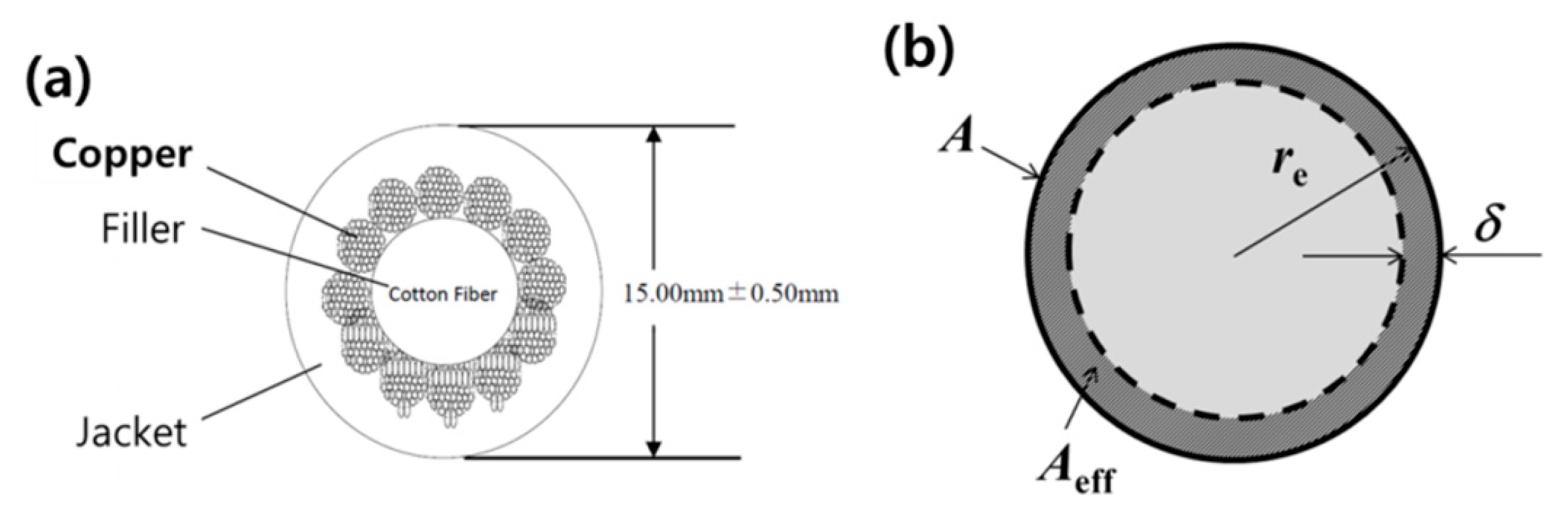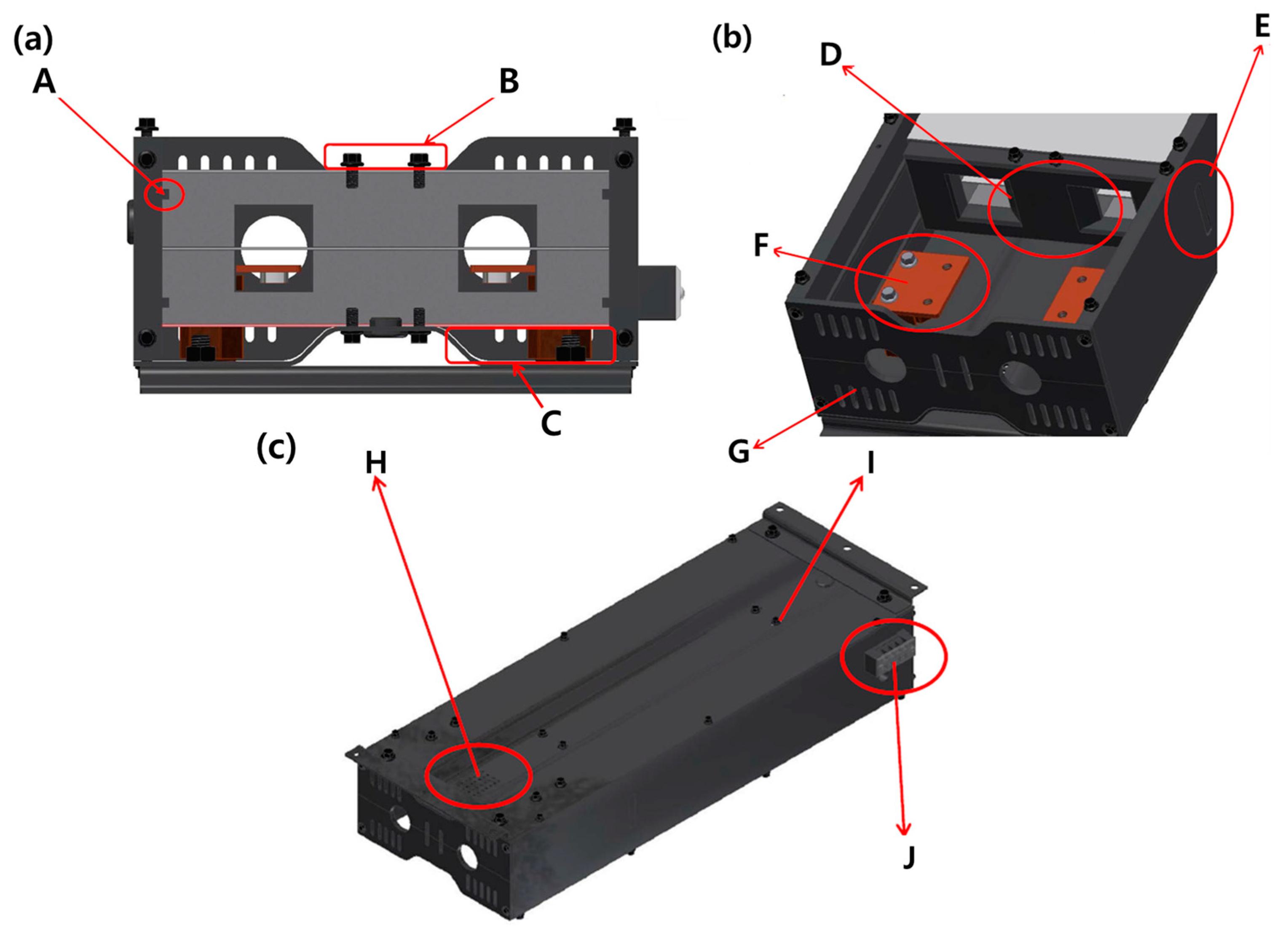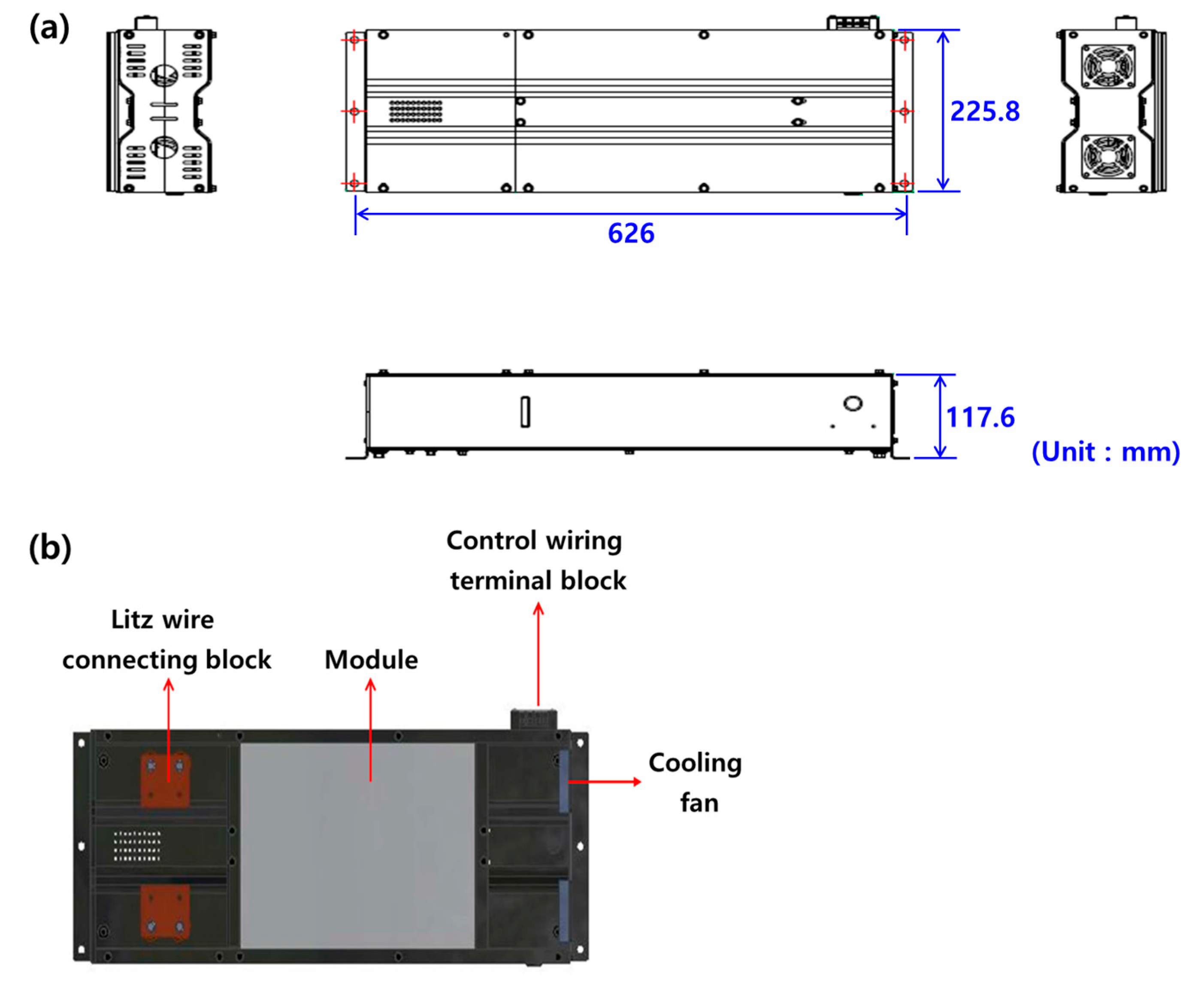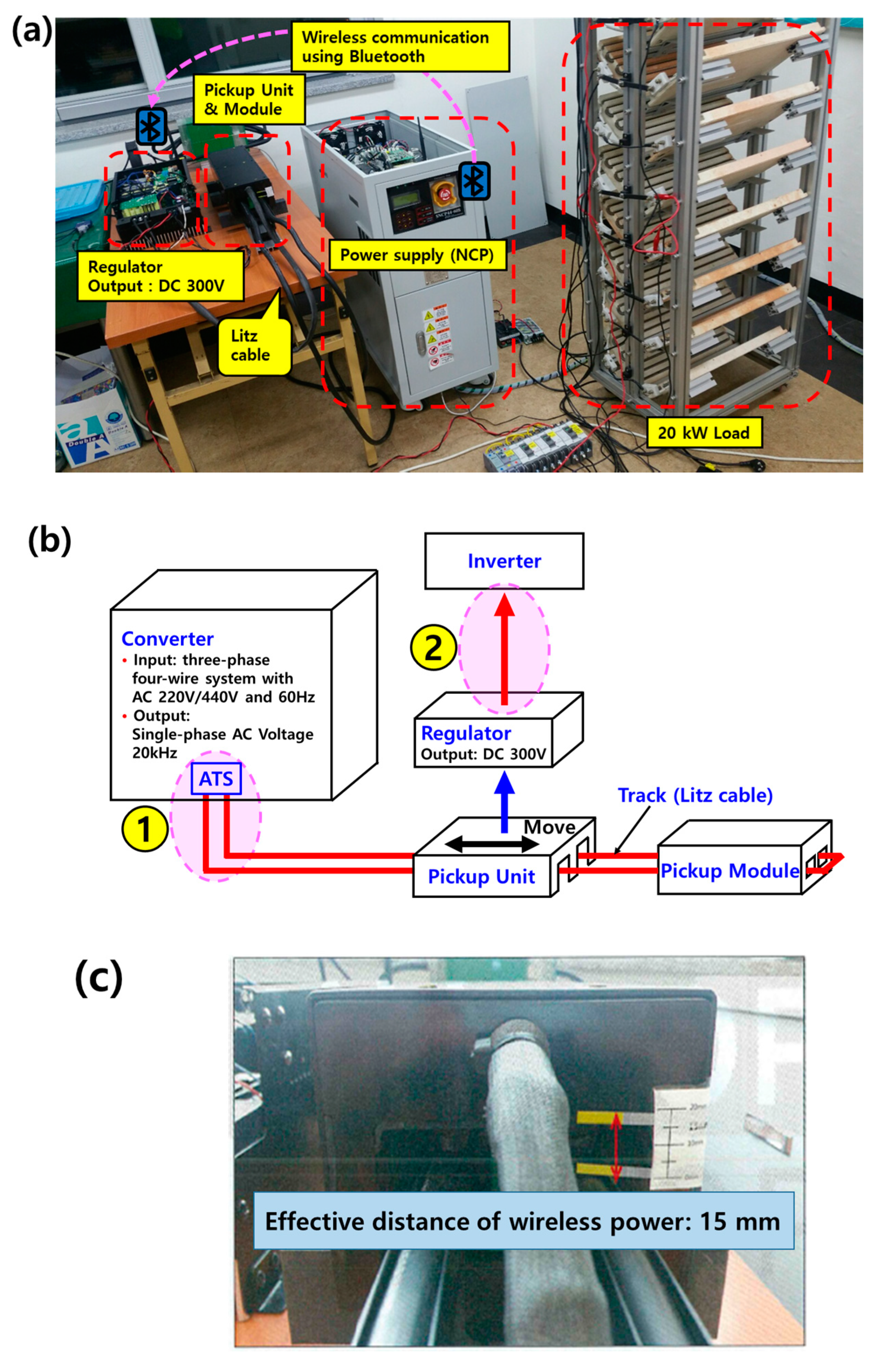Development of Wireless Power Transmission System for Transfer Cart with Shortened Track
Abstract
1. Introduction
- Design to maximize efficiency considering several key design parameters of the coil,
- Coil design considering high efficiency, electromagnetic interface (EMI), electromagnetic field (EMF), and form factor,
- The selection of an appropriate frequency for maximum efficiency, minimum material loss, and minimum EMF,
- An active shielding method using a resonant loop current shielding (RLCS) canceller,
- Structural designs to improve the heat transfer performance of a module,
- Module fabrication for performance verification.
2. Power Transfer System Design
3. Thermal Analysis and Pickup Module Fabrication
3.1. Thermal Analysis
3.2. Pickup Module Fabrication
4. Test Method and Result
5. Conclusions
- An appropriate frequency was selected and active technology was developed by using an RLCS canceller.
- Structural designs were achieved to improve high heat transfer.
- A simple approach was also proposed to estimate the skin depth in a cable, which is made up of multiple strands of multiple wires. This approach was validated through thermal analysis by using ANSYS software considering heat generation by an electric field. The resulting temperature profile was in good agreement with those obtained from experiments.
- We discussed the fabrication of a dummy for shortened tracks for diverse uses. To facilitate the application of the L-dummy, it was designed to fit in the shape of a hole and improve the cooling capacity of the dummy, thereby improving the cooling capacity of the system and minimizing the heat generated by the Litz wire to reduce the damage caused by the edges of the system.
Author Contributions
Funding
Acknowledgments
Conflicts of Interest
References
- Kurs, A.; Karalis, A.; Moffatt, R.; Joannopoulos, J.D.; Fisher, P.; Soljačic, M. Wireless Power Transfer via Strongly Coupled Magnetic Resonances. Science 2007, 317, 83–86. [Google Scholar] [CrossRef] [PubMed]
- Tomar, A.; Gupta, S. Wireless power transmission: Applications and components. Int. J. Eng. 2012, 1, 1–8. [Google Scholar]
- Wei, X.; Wang, Z.; Dai, H. A critical review of wireless power transfer via strongly coupled magnetic resonances. Energies 2014, 7, 4316–4341. [Google Scholar] [CrossRef]
- Li, S.; Mi, C.C. Wireless power transfer for electric vehicle applications. IEEE J. Emerg. Sel. Top. Power Electron. 2015, 3, 4–17. [Google Scholar]
- Das Barman, S.; Reza, A.W.; Kumar, N.; Karim, E.; Munir, A.B. Wireless powering by magnetic resonant coupling: Recent trends in wireless power transfer system and its applications. Renew. Sustain. Energy Rev. 2015, 51, 1525–1552. [Google Scholar] [CrossRef]
- Song, M.; Iorsh, I.; Kapitanova, P.; Nenasheva, E.; Belov, P. Wireless power transfer based on magnetic quadrupole coupling in dielectric resonators. Appl. Phys. Lett. 2016, 108, 023902. [Google Scholar] [CrossRef]
- Kim, Y.-J.; Ha, D.; Chappell, W.J.; Irazoqui, P.P. Selective wireless power transfer for smart power distribution in a miniature-sized multiple-receiver system. IEEE Trans. Ind. Electron. 2015, 63, 1853–1862. [Google Scholar] [CrossRef]
- Rodríguez, E.S.G.; Ramrakhyani, A.K.; Schurig, D.; Lazzi, G. Compact low-frequency metamaterial design for wireless power transfer efficiency enhancement. IEEE Trans. Microw. Theory Tech. 2016, 64, 1644–1654. [Google Scholar] [CrossRef]
- Bi, Z.; Kan, T.; Mi, C.; Zhang, Y.; Zhao, Z.; Keoleian, G.A. A review of wireless power transfer for electric vehicles: Prospects to enhance sustainable mobility. Appl. Energy 2016, 179, 413–425. [Google Scholar] [CrossRef]
- Nakamura, S.; Namiki, M.; Sugimoto, Y.; Hashimoto, H. Q Controllable Antenna as a Potential Means for Wide-Area Sensing and Communication in Wireless Charging via Coupled Magnetic Resonances. IEEE Trans. Power Electron. 2017, 32, 218–232. [Google Scholar] [CrossRef]
- Lee, J.; Lee, K.; Cho, D.-H. Stability Improvement of Transmission Efficiency Based on a Relay Resonator in a Wireless Power Transfer System. IEEE Trans. Power Electron. 2017, 32, 3297–3300. [Google Scholar] [CrossRef]
- Assawaworrarit, S.; Yu, X.; Fan, S. Robust wireless power transfer using a nonlinear parity–time-symmetric circuit. Nature 2017, 546, 387–390. [Google Scholar] [CrossRef] [PubMed]
- Chen, M.; Gonzalez, S.; Vasilakos, A.; Cao, H.; Leung, V.C.M. Body area networks: A survey. Mob. Netw. Appl. 2011, 16, 171–193. [Google Scholar] [CrossRef]
- Carretero, C. Coupling Power Losses in Inductive Power Transfer Systems With Litz-Wire Coils. IEEE Trans. Ind. Electron. 2017, 64, 4474–4482. [Google Scholar] [CrossRef]
- Giovannetti, G.; Tiberi, G. Skin Effect Estimation in Radiofrequency Coils for Nuclear Magnetic Resonance Applications. Appl. Magn. Reson. 2016, 47, 601–612. [Google Scholar] [CrossRef]
- Kim, J.; Kim, J.; Kong, S.; Kim, H.; Suh, I.-S.; Suh, N.P.; Cho, D.-H.; Kim, J.; Ahn, S. Coil design and shielding methods for a magnetic resonant wireless power transfer system. Proc. IEEE 2013, 101, 1332–1342. [Google Scholar] [CrossRef]
- Jordan, E.; Balmain, K. Electromagnetic Waves and Radiating Systems; Prentice Hall: Upper Saddle River, NJ, USA, 1968. [Google Scholar]
- Huang, M.-S.; Huang, Y.-L. Effect of multi-layered induction coils on efficiency and uniformity of surface heating. Int. J. Heat Mass Tranf. 2010, 53, 2414–2423. [Google Scholar] [CrossRef]
- Jung, S.; Ariyur, K.B. Automated Wireless Recharging for Small UAVs. Int. J. Aeronaut. Space Sci. 2017, 18, 588–600. [Google Scholar] [CrossRef]
- Zinn, S.; Semiatin, S. Coil design and fabrication: basic design and modifications. Heat Treat. 1988, 12, 32–36. [Google Scholar]
- Suh, I.S. Application of shaped magnetic field in resonance (SMFIR) technology to future urban transportation. In Proceedings of the 21st CIRP Design Conference, Daejeon, Korea, 27–29 March 2011; pp. 226–232. [Google Scholar]
- Ahn, S.; Pak, J.; Song, T.; Lee, H.; Byun, J.-G.; Kang, D.; Choi, C.-S.; Kim, E.; Ryu, J.; Kim, M.; et al. Low frequency electromagnetic field reduction techniques for the on-line electric vehicle (OLEV). In Proceedings of the 2010 IEEE International Symposium on Electromagnetic Compatibility, Fort Lauderdale, FL, USA, 25–30 July 2010. [Google Scholar]
- Kim, H.J.; Song, J.H.; Jin, J.S. Design of WPT System using Optimized Dummy to Shorten Track. In Proceedings of the Korean Society of Mechanical Engineering 2018 Spring Annual Meeting of Honam Branch, Jeonju, Korea, 25 May 2018; KSME2018R1029. pp. 76–78. [Google Scholar]
- Bash, B.A.; Goeckel, D.; Towsley, D. Limits of reliable communication with low probability of detection on AWGN channels. IEEE J. Sel. Areas Commun. 2013, 31, 1921–1930. [Google Scholar] [CrossRef]
- Zhukov, A.; Talaat, A.; Ipatov, M.; Granovsky, A.; Zhukova, V. Estimation of the frequency and magnetic field dependence of the skin depth in Co-rich magnetic microwires from GMI experiments. J. Sci. Adv. Mater. Devices 2016, 1, 388–392. [Google Scholar] [CrossRef]
- Hwang, K.; Chun, S.; Yoon, U.; Lee, M.; Ahn, S.; Chung, S. Thermal Analysis for Temperature Robust Wireless Power Transfer Systems. In Proceedings of the 2013 IEEE Wireless Power Transfer (WPT), Perugia, Italy, 15–16 May 2013; pp. 52–55. [Google Scholar]
- Incropera, F.P.; DeWitt, D.P. Fundamental of Heat and Mass Transfer, 4th ed.; John Wiley & Sons, Inc.: New York, NY, USA, 1996. [Google Scholar]
- Versteeg, H.K.; Malalasekera, W. An Introduction to Computational Fluid Dynamics: The Finite Volume Method; Pearson Education: New York, NY, USA, 2007. [Google Scholar]
- Joule, J. India-Rubber in: The Scientific Papers of James Prescott Joule; Taylor and Francis: London, UK, 1884; Volume 1. [Google Scholar]






| Property | Bakelite | Ferrite Core | Effective Value |
|---|---|---|---|
| Thermal conductivity (W/m∙K) | 1.4 | 4.25 | 3.32 |
| Density (kg/m3) | 1300 | 5000 | 3794.9 |
| Specific heat (J/kg∙K) | 1465 | 750 | 982.9 |
| Volume (m3) | 1.58 × 10−3 (32.6%) | 3.27 × 10−3 (67.4%) | - |
| Parameter | No. 1 | No. 2 |
|---|---|---|
| Voltage (V) | 318.06 | 287.80 |
| Current (A) | 81.34 | 74.83 |
| Power (W) | 25,871.0 | 21,546.07 |
| Charging efficiency (%) | 83.24 | |
© 2020 by the authors. Licensee MDPI, Basel, Switzerland. This article is an open access article distributed under the terms and conditions of the Creative Commons Attribution (CC BY) license (http://creativecommons.org/licenses/by/4.0/).
Share and Cite
Jin, J.S.; Jung, S.; Kim, H.J. Development of Wireless Power Transmission System for Transfer Cart with Shortened Track. Appl. Sci. 2020, 10, 4694. https://doi.org/10.3390/app10144694
Jin JS, Jung S, Kim HJ. Development of Wireless Power Transmission System for Transfer Cart with Shortened Track. Applied Sciences. 2020; 10(14):4694. https://doi.org/10.3390/app10144694
Chicago/Turabian StyleJin, Jae Sik, Sunghun Jung, and Han Joo Kim. 2020. "Development of Wireless Power Transmission System for Transfer Cart with Shortened Track" Applied Sciences 10, no. 14: 4694. https://doi.org/10.3390/app10144694
APA StyleJin, J. S., Jung, S., & Kim, H. J. (2020). Development of Wireless Power Transmission System for Transfer Cart with Shortened Track. Applied Sciences, 10(14), 4694. https://doi.org/10.3390/app10144694






